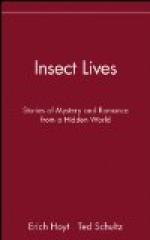[Illustration: Fig. 9. Nymph of May-fly (Chloeon dipterum) showing on right side wing-rudiment (a), on left tracheal gills (b). Magnified 4 times. [Feelers and legs are cut short.] From Miall and Denny after Vayssiere.]
In the development of the may-flies, then, we notice not only a considerable divergence between larva and imago, both in habitat and structure; we see also what is to be observed often in more highly organised insects—a feeding stage prolonged through the years of larval and nymphal life, while the winged imago takes no food and devotes its energies through its short existence to the task of reproduction. Such division of the life-history into a long feeding, and a short breeding period has, as will be seen later, an important bearing on the question of insect transformation generally, and the dragon-flies and may-flies afford examples of two stages in its specialisation. The sub-imaginal instar of the may-fly furnishes also a noteworthy fact for comparison with other insect histories. In two points, however, the life-story of these flies with their aquatic larvae recalls that of the cockroach. All the larval and nymphal instars are active, and the wing-rudiments are outwardly visible long before the final moult.
CHAPTER V
TRANSFORMATIONS,—OUTWARD AND INWARD
We are now in a position to study in some detail the transformation of those insects whose life-story corresponds more or less closely with that of the butterfly, sketched in the opening pages of this little book. In the case of some of the insects reviewed in the last three chapters, the may-flies and cicads for example, a marked difference between the larva and the imago has been noticed; in others, as the coccids, we find a resting instar before the winged condition is assumed, suggesting the pupal stage in the butterfly’s life-story.
The various insect orders whose members exhibit no marked divergence between larva and imago (the Orthoptera for example) are often said to undergo no transformation, to be ‘Ametabola.’ Those with life-stories such as the dragon-flies’ are said to undergo partial transformation, and are termed ‘Hemimetabola.’ Moths, caddis-flies, beetles, two-winged flies, saw-flies, ants, wasps, bees, and the great majority of insects, having the same type of life-story as the butterfly, are said to undergo complete transformation and are classed as ‘Metabola’ or ‘Holometabola.’ Wherein lies the fundamental difference between these Holometabola on the one hand and the Hemimetabola and Ametabola on the other? It is not that the larva differs from the imago or that there is a passive stage in the life-history; these conditions are observable among insects with a ‘partial’ transformation as we have seen, though the resting instar that simulates the butterfly pupa is certainly exceptional. It has been pointed out by Sharp (1899) that the most important indication of the difference between the two modes of development is furnished by the position of the wing-rudiments. In all Ametabola and Hemimetabola these are visible externally long before the penultimate instar has been reached; in the Holometabola they are not seen until the pupal stage.




